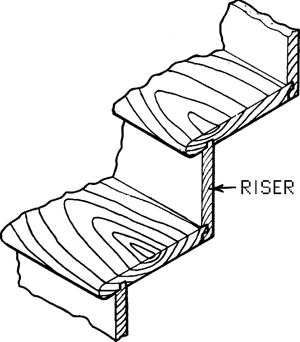riser
1. the vertical part of a stair or step
2. a vertical pipe, esp one within a building
Collins Discovery Encyclopedia, 1st edition © HarperCollins Publishers 2005
Riser
1. The vertical board under the tread of a step; a vertical supply pipe for a sprinkler system; a pipe for water, drainage, gas, steam, or venting that extends vertically through one or more stories and services other pipes.
2. The vertical face of a stair step.
 See also: Step
See also: StepIllustrated Dictionary of Architecture Copyright © 2012, 2002, 1998 by The McGraw-Hill Companies, Inc. All rights reserved
riser
[′rīz·ər] (chemical engineering)
That portion of a bubble-cap assembly in a distillation tower that channels the rising vapor and causes it to flow downward to pass through the liquid held on the bubble plate.
(civil engineering)
A board placed vertically beneath the tread of a step in a staircase.
A vertical steam, water, or gas pipe.
(geology)
A steplike topographic feature, such as a steep slope between terraces.
(metallurgy)
(petroleum engineering)
In an offshore drilling facility, a system of piping extending from the hole and terminating at the rig.
(textiles)
A raised spot in a weaving pattern where the warp traverses the weft or the filling.
McGraw-Hill Dictionary of Scientific & Technical Terms, 6E, Copyright © 2003 by The McGraw-Hill Companies, Inc.
riser

riser, 1
1. The vertical face of a stair step.
2. Any upright face, as of a seat, platform, etc.
3. A platform on the stage of a theater or concert hall on which a performer is placed.
4. A water-supply, drainage, gas, steam, or vent pipe which extends vertically, one full story or more, to service several branches or a group of fixtures.
5. An electrical cable which extends vertically, one full story or more, to distribute electrical power to electric panels on the different floors of a building.
6. A duct, which extends vertically, one full story or more, to distribute air to branch ducts on the different floors of a building.
7. A vertical supply pipe for a fire sprinkler system.
McGraw-Hill Dictionary of Architecture and Construction. Copyright © 2003 by McGraw-Hill Companies, Inc.